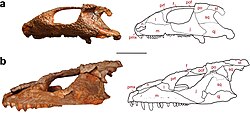| Nycteroleterids Temporal range: Middle Permian, | |
|---|---|
 | |
| Adult and juvenile skulls of Macroleter (= Tokosaurus ) | |
 | |
| Life restoration of Emeroleter | |
| Scientific classification | |
| Domain: | Eukaryota |
| Kingdom: | Animalia |
| Phylum: | Chordata |
| Clade: | † Parareptilia |
| Order: | † Procolophonomorpha |
| Clade: | † Pareiasauromorpha |
| Family: | † Nycteroleteridae Romer, 1956 |
| Genera [1] | |
| |
Nycteroleteridae is a family of procolophonian parareptilians (extinct early reptiles) from the Middle to Late Permian of Russia and North America. They are sometimes classified as a sister group to pareiasaurids (but see Classification). The group includes the genera Macroleter , Bashkyroleter , "Bashkyroleter" mesensis, Nycteroleter , Emeroleter , and probably Rhipaeosaurus . They were carnivorous, and occasionally ate insects. [1] The group was most common in European Russia, with only a few fossils in North America. One fossil has also been found in Africa, but this is the only one from Gondwana. [2]


